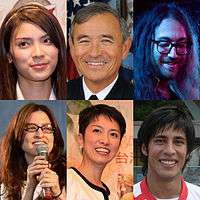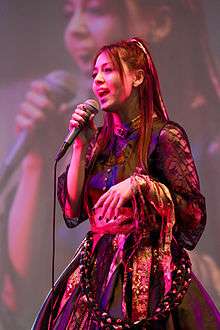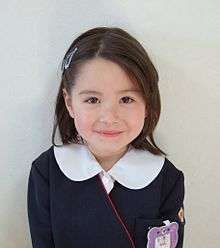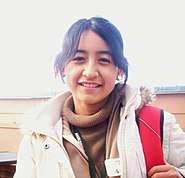Hāfu

The word hāfu (ハーフ, "half") is used in Japanese to refer to somebody who is biracial with half Japanese ethnic origin. The label emerged in the 1970s in Japan and is now the most commonly used and preferred term of self-definition. The word comes from the English word half, indicating half foreign-ness.[1][2][3][4]
Social context
Fashionable images of the half Japanese people have become prominent especially with the increased appearance of hāfu in the Japanese media.[5] Hāfu models are now seen on television or fill the pages of fashion magazines such as Non-no, CanCam and Vivi as often as newsreaders or celebrities. The appearance of hāfu in the media has provided the basis for such a vivid representation of them in the culture.[6][7]
One of the earliest terms referring to half Japanese was ainoko, meaning a child born of a relationship between two races. It is still used in Latin America, most prominently Brazil (where spellings such as ainoco, ainoca (f.) and ainocô may be found), to refer to mestizo (broader Spanish sense of mixed race in general) or mestiço people of some Japanese ancestry. Nevertheless, it evolved to an umbrella term for Eurasian or mixed Asian/mestizo, Asian/black, Asian/Arab and Asian/Indigenous heritage in general. At the same time it is possible for people with little Japanese or other Asian ancestry to be perceivable just by their phenotype to identify mostly as black, white or mestizo/pardo instead of ainoko, while people with about a quarter or less of non-Asian ancestry may identify just as Asian.
Ainoko, however, encountered social problems such as poverty, perception of impurity and discrimination due to the negative treatment of hāfu in the 1940s in Japan. The word was gradually replaced from the late 1950s by konketsuji (混血児) which literally means a child of mixed blood.[8]
Soon this, too, became a taboo term due to its derogatory connotations such as illegitimacy and discrimination. What were central to these labels were the emphasis on "blood impurity" and the obvious separation of the half Japanese from the majority of Japanese. Some English-speaking parents of children of mixed ethnicity use the word "double."[8] Amerasian is another term for children of mixed ancestry, especially those born to Japanese mothers and U.S. military fathers.
Of the 1 million children born in Japan in 2013, 2.2% had one or more non-Japanese parent.[70] According to the Japanese Ministry of Health, Labor and Welfare, one in forty-nine babies born in Japan today are born into families with one non-Japanese parent.[9] Most intermarriages in Japan are between Japanese men and women from other Asian countries, including China, the Philippines and South Korea.[10] Southeast Asia too, also has significant populations of people with half Japanese ancestry, particularly in the Philippines, Indonesia, Malaysia, Singapore and Thailand.
In the 21st century, stereotyping and discrimination against hāfu occurs based on how different their identity, behaviour and appearance is from a typical Japanese person.
The 2013 documentary film Hafu is about the experiences of hāfu living in Japan and deals with issues of identity and stereotyping that they face.[11][12]
List of famous hāfu


.jpg)
_(36143097936).jpg)
- Abdul Hakim Sani Brown, sprinter
- Alan Shirahama, singer and member of the Generations from Exile Tribe
- Alice Sara Ott, pianist, half German
- Amy Hill, comedienne and actress, half Finnish American
- Angela Aki, pop singer, songwriter and pianist, half Italian American
- Ann Curry, TV journalist
- Anna Akana, YouTube personality
- Anna Murashige, idol singer, half Russian
- Anna Tsuchiya, singer, actress, model
- Anza, singer and actress, half White South African
- Apolo Ohno, speed skater
- Arata Izumi, footballer, half Indian
- Ariana Miyamoto, Miss Universe Japan 2015, half African American
- Asuka Cambridge, sprinter, half Jamaican
- Ayako Fujitani, actress; daughter of Steven Seagal
- Ayana Shahab, idol singer, half Arab Indonesian[13]
- Ayumi Horie, potter and artist
- Becky, television personality
- Bobby Wood, footballer
- Christel Takigawa, television presenter
- Christian Yelich, baseballer
- Christopher Sean, actor
- Crystal Kay, singer, actress
- David Silva, footballer
- Denny Tamaki, Japanese politician and the current Governor of Okinawa Prefecture
- Devon Aoki, fashion model
- Don Wakamatsu, baseballer
- Eiji Wentz, singer, entertainer and actor
- Elle McLemore, actress
- Erika Sawajiri, actress, singer, idol, model, half Algerian
- Genki Dean, javelin thrower
- George Miller, record producer, singer, songwriter and retired YouTube personality, half Australian
- Gōtoku Sakai, footballer
- Harry B. Harris Jr., four-star admiral in the United States Navy, half Caucasian American
- Hideki Irabu, baseballer
- Ian Anthony Dale, actor
- Irina Khakamada, politician
- Isamu Noguchi, artist, designer
- Issa Lish, model
- Jero, first black enka singer, half African American
- Kaela Kimura, pop rock singer
- Karyn Kusama, filmmaker
- Keone Young, actor
- Kiko Mizuhara, pop rock singer
- Koji Murofushi, Olympic gold medal-winning hammer thrower
- Kyla Ross, gymnast
- Louisa Krause, actress
- Luma Grothe, model
- Lyoto Machida, mixed martial artist, former UFC Light Heavyweight Champion
- Maiko Nakamura, singer
- Maria Ozawa, actress, model and former AV idol, half French Canadian
- Marie Digby, singer
- Marie Helvin, fashion model and writer
- Marius Yo, singer
- Mark Ishii, voice actor
- Masato David Hayakawa, vocalist of Coldrain
- Mashu Baker, 2016 Olympic gold medalist, half Caucasian American
- Mayumi Sada, actress
- Megumi Nakajima, voice actress, singer
- Meisa Kuroki, actress
- Miho Fukuhara, singer
- Mike Shinoda, musician, co-founder of the rock band Linkin Park
- Mitski Miyawaki, singer
- Miyavi, rock, guitarist and actor
- Musashi Suzuki, footballer
- Namie Amuro, singer, quarter Italian[14]
- Naomi Osaka, tennis player, 2018 US Open winner, half Haitian
- Nichole Bloom, actress and model
- Nicola Formichetti, fashion director and fashion editor
- Nicole Fujita, model and tarento
- Paulo Nagamura, footballer
- Rie Fujioka, musician and composer
- Priyanka Yoshikawa, Miss Japan 2016
- Reiko Aylesworth, actress
- Reina Triendl, actress, talent, model
- Renhō, journalist and politician, leader of the Democratic Party of Japan, half Taiwanese
- Richard von Coudenhove-Kalergi, President of the Paneuropean Union, half Austro-Hungarian
- Rikako Sasaki, singer
- Rola, model, talent and actress, half Bangladeshi
- Sabrina Sato, television personality
- Sadaharu Oh, famous baseball player
- Sarah Midori Perry, singer and artist, half British
- Sayaka Akimoto, television host and model, half Filipino
- Sean Taro Ono Lennon (Ono Tarō), singer, songwriter and actor, half English
- Shūhei Nomura, actor
- Sonoya Mizuno, actress
- Stefan Ishizaki, footballer
- Stephanie, singer, half Armenian
- Steve Aoki, DJ
- Subaru Kimura, voice actor
- Tadanobu Asano, actor
- Taihō Kōki, 48th yokozuna in the Japanese sport of sumo wrestling
- Takayasu Akira, sumo wrestler, half Filipino
- Takeshi Kaneshiro, actor
- Tamlyn Tomita, actress
- Taro Daniel, tennis player
- Tina Tamashiro, model and fashion designer
- Tomio Okamura, politician
- Yu Darvish, pitcher for the Chicago Cubs Major League Baseball team, half Iranian
- Yu Shirota, actor and singer
- Yuichi Matsumoto, baseball player
- Yuki Kato, actress, half Indonesian
- Yumi Lambert, model
- Yūsaku Matsuda, actor
Hāfu in popular culture
- Shuichi Akai (half British)
- Giorno Giovanna (half English)
- Josuke Higashikata (half English)
- Jotaro Kujo (quarter English, quarter Italian)
- Jolyne Cujoh
- Kazuhira Miller
- Masumi Sera (half British)
- Mikasa Ackerman
- Takumi Usui
- Tamaki Suoh
- Pegasus Tenma
- Tsuna Sawada
- Hiro Hamada (half Caucasian)
- Shukichi Haneda (half British)
- Cygnus Hyōga
- Eli Ayase (quarter Russian)
- Arsene Lupin III (half French)
- Asuka Langley Soryu (half German)
- Hayato Gokudera
- Buckaroo Banzai
- Daken (half Canadian)
- Yasutora Sado
- Mukuro Rokudo
- Rin Okumura
- Ai Haibara (half English)[15]
- Mari Ohara (quarter Italian)
- Kallen Stadtfeld (half English)
- Taichi Hiraga-Keaton
- Eve Wakamiya (half Finnish)
See also
References
- ↑ Krieger, Daniel (29 November 2010). "The whole story on being 'hafu'". CNN. Archived from the original on 2010-12-03. Retrieved 2011-04-12.
- ↑ Navidi, Nooshin (22 June 2010). "Hafu draws viewers into world of Japanese identity". Japan Times. Archived from the original on 2011-12-01. Retrieved 2011-04-12.
- ↑ Yamada, Mio (28 February 2009). "Hafu focuses on whole individual". Japan Times. Archived from the original on 2011-12-16. Retrieved 2011-04-12.
- ↑ Fujioka, Brett (14 January 2011). "The Other Hafu of Japan". Rafu Shimpo. Archived from the original on 2011-01-22. Retrieved 2011-04-12.
- ↑ "Growing Up Different but Never Alienated". The Los Angeles Times. Archived from the original on 2014-12-30. Retrieved 2012-03-18.
- ↑ Japan and Global Migration: Foreign Workers and the Advent of a ... - Mike Douglass, Glenda Susan Roberts - Google Books. Books.google.co.uk. Retrieved 2012-07-26.
- ↑ American Mixed Race: The Culture of Microdiversity - Naomi Zack - Google Books. Books.google.co.uk. Retrieved 2012-07-26.
- 1 2 Kosaka, Kristy (2009-01-27). "Half, bi or double? One family's trouble". Japan Times. Retrieved 2011-11-20.
- ↑ "About the film | Hafu". hafufilm.com. Archived from the original on 2016-10-15. Retrieved 2016-09-14.
- ↑ "Being 'hafu' in Japan: Mixed-race people face ridicule, rejection". Archived from the original on 2017-05-20. Retrieved 2017-05-01.
- ↑ "Documentary shows hardships of mixed-race individuals in Japan - AJW by The Asahi Shimbun". Ajw.asahi.com. Archived from the original on 2013-10-13. Retrieved 2013-10-20.
- ↑ Shoji, Kaori. "Double the trouble, twice the joy for Japan's hafu". The Japan Times. Archived from the original on 2013-10-28. Retrieved 2013-10-20.
- ↑ Fagiputra, A. "10 Potret Ayana JKT48, Imutnya Bikin Klepek-klepek". IDN Times (in Indonesian). Archived from the original on 2018-05-01. Retrieved 2018-05-01.
- ↑ "She, herself and AI | The Japan Times". The Japan Times. Archived from the original on 2016-04-28. Retrieved 2018-05-27.
- ↑ Aoyama, Gosho (2018). "Chapter 1011". Case Closed.
External links
- Hafu Film
- The Hafu Project - By artist Natalie Maya Willer and researcher Marcia Yumi Lise
- Halvsie
- Hapa Japan
- "“This Is Who I Am”: Jero, Young, Gifted, Polycultural" -(Fellezs 2012)
- Die Kreuzungsstelle -voices of half Japanese, mixed race/multiracial or multiethnic persons
- Biracial Beauty Queen Challenges Japan’s Self-Image, NYT

